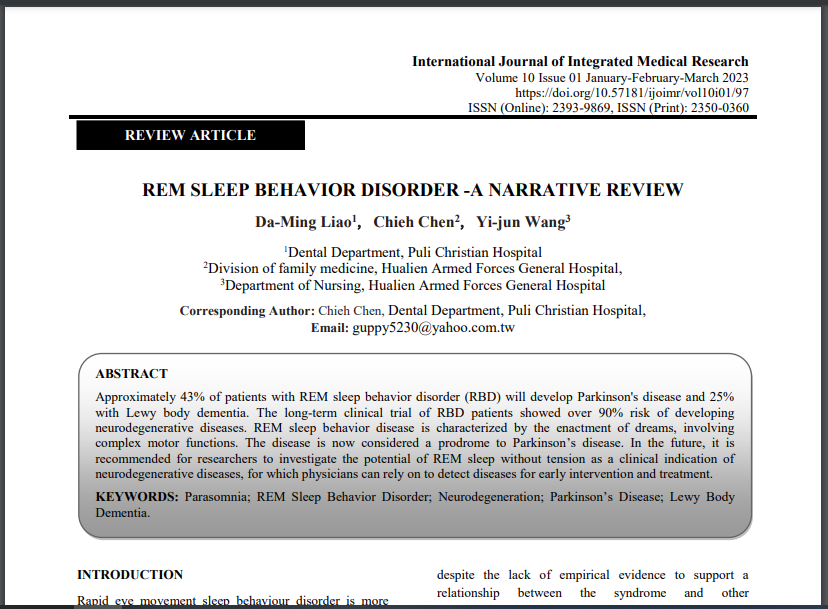REM Sleep Behavior Disorder -A Narrative Review
Main Article Content
Abstract
Approximately 43% of patients with REM sleep behavior disorder (RBD) will develop Parkinson's disease and 25% with Lewy body dementia. The long-term clinical trial of RBD patients showed over 90% risk of developing neurodegenerative diseases. REM sleep behavior disease is characterized by the enactment of dreams, involving complex motor functions. The disease is now considered a prodrome to Parkinson’s disease. In the future, it is recommended for researchers to investigate the potential of REM sleep without tension as a clinical indication of neurodegenerative diseases, for which physicians can rely on to detect diseases for early intervention and treatment.
Article Details
References
• Howell MJ, Schenck CH. Rapid eye movement sleep behavior disorder and neurodegenerative disease. JAMA neurology 2015; 72(6): 707-12.
• Högl B, Stefani A, Videnovic A. Idiopathic REM sleep behaviour disorder and neurodegeneration-an update. Nature Reviews Neurology 2018; 14(1): 40-55.
• Gagnon JF, Postuma RB, Mazza S, et al. Rapid-eye-movement sleep behaviour disorder and neurodegenerative diseases. The Lancet Neurology 2006; 5(5): 424-32.
• Iranzo A, Tolosa E, Gelpi E, et al. Neurodegenerative disease status and post-mortem pathology in idiopathic rapid-eye-movement sleep behaviour disorder: an observational cohort study. The Lancet Neurology 2013; 12(5): 443-53.
• Galbiati A, Verga L, Giora E, Zucconi M, Ferini-Strambi L. The risk of neurodegeneration in REM sleep behavior disorder: A systematic review and meta-analysis of longitudinal studies. Sleep medicine reviews 2019; 43: 37-46.
• Antelmi E, Lippolis M, Biscarini F, et al. REM sleep behavior disorder: mimics and variants. Sleep Medicine Reviews 2021; 60: 101515.
• Stefani A, Holzknecht E, Högl B. Clinical neurophysiology of REM parasomnias. Handbook of clinical neurology 2019; 161: 381-96.
• Iranzo A, Molinuevo JL, Santamaría J, et al. Rapid-eye-movement sleep behavior disorder as an early marker for a neurodegenerative disorder: a descriptive study. The Lancet Neurology 2006; 5(7): 572-7.
• Haba-Rubio J, Frauscher B, Marques-Vidal P, et al. Prevalence and determinants of rapid eye movement sleep behavior disorder in the general population. Sleep 2018; 41(2): 1-8.
• Postuma RB, Gagnon JF, Vendette M, Montplaisir JY. Markers of neurodegeneration in idiopathic rapid eye movement sleep behavior disorder and Parkinson's disease. Brain 2009; 132(12): 3298-3307.
• Olson EJ, Boeve BF, Silber MH. Rapid eye movement sleep behaviour disorder: demographic, clinical and laboratory findings in 93 cases. Brain 2000; 123(2): 331-9.
• Iranzo A, Fernández-Arcos A, Tolosa E, et al. Neurodegenerative disorder risk in idiopathic REM sleep behavior disorder: study in 174 patients. PloS one 2014; 9(2): e89741.
• Fasiello E, Scarpelli S, Gorgoni M, Alfonsi V, De Gennaro L. Dreaming in Parasomnias: REM Sleep Behavior Disorder as a Model. Journal of Clinical Medicine 2022, 11(21): 6379.
• Schenck CH. REM sleep behavior disorder as a complex condition with heterogeneous underlying disorders: clinical management and prognostic implications. Sleep and Breathing 2022: 1-10.
• Videnovic A, Babu S, Zhao B, Reda HM, Linnoila JJ. Case 1-2022: a 67-year-old man with motor neuron disease and odd behaviors during sleep. New England Journal of Medicine 2022; 386(2): 173-80.
• Leitner C, D’Este G, Verga L, Rahayel S, Mombelli S, Sforza M, et al. Neuropsychological changes in isolated REM sleep behavior disorder: A systematic review and meta-analysis of cross-sectional and longitudinal studies. Neuropsychology Review 2023: 1-26.
• McGrane IR, Leung JG, Louis EKS, Boeve BF. Melatonin therapy for REM sleep behavior disorder: a critical review of evidence. Sleep medicine 2015; 16(1): 19-26.
